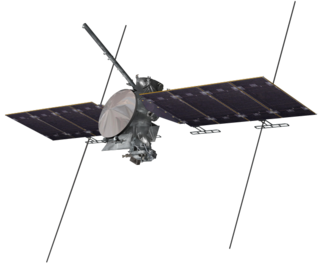Related Research Articles
Human spaceflight programs have been conducted, started, or planned by multiple countries and companies. Until the 21st century, human spaceflight programs were sponsored exclusively by governments, through either the military or civilian space agencies. With the launch of the privately funded SpaceShipOne in 2004, a new category of human spaceflight programs – commercial human spaceflight – arrived. By the end of 2022, three countries and one private company (SpaceX) had successfully launched humans to Earth orbit, and two private companies had launched humans on a suborbital trajectory.

A spaceplane is a vehicle that can fly and glide like an aircraft in Earth's atmosphere and maneuver like a spacecraft in outer space. To do so, spaceplanes must incorporate features of both aircraft and spacecraft. Orbital spaceplanes tend to be more similar to conventional spacecraft, while sub-orbital spaceplanes tend to be more similar to fixed-wing aircraft. All spaceplanes to date have been rocket-powered for takeoff and climb, but have then landed as unpowered gliders.

A CubeSat is a class of small satellite with a form factor of 10 cm (3.9 in) cubes. CubeSats have a mass of no more than 2 kg (4.4 lb) per unit, and often use commercial off-the-shelf (COTS) components for their electronics and structure. CubeSats are deployed into orbit from the International Space Station, or launched as secondary payloads on a launch vehicle. As of December 2023, more than 2,300 CubeSats have been launched.

Blue Origin Enterprises, L.P., commonly referred to as Blue Origin is an American aerospace manufacturer, defense contractor, launch service provider and space technologies company headquartered in Kent, Washington, United States. The company makes rocket engines for United Launch Alliance (ULA)'s Vulcan rocket and manufactures their own rockets, spacecraft, satellites, and heavy-lift launch vehicles. The company is the second provider of lunar lander services for NASA's Artemis program and was awarded a $3.4 billion contract. The four rocket engines the company has in production are the BE-3U, BE-3PM, BE-4 and the BE-7.

A small satellite, miniaturized satellite, or smallsat is a satellite of low mass and size, usually under 1,200 kg (2,600 lb). While all such satellites can be referred to as "small", different classifications are used to categorize them based on mass. Satellites can be built small to reduce the large economic cost of launch vehicles and the costs associated with construction. Miniature satellites, especially in large numbers, may be more useful than fewer, larger ones for some purposes – for example, gathering of scientific data and radio relay. Technical challenges in the construction of small satellites may include the lack of sufficient power storage or of room for a propulsion system.
Environmental Defense Fund or EDF is a United States-based nonprofit environmental advocacy group. The group is known for its work on issues including global warming, ecosystem restoration, oceans, and human health, and advocates using sound science, economics and law to find environmental solutions that work. It is nonpartisan, and its work often advocates market-based solutions to environmental problems.

United Launch Alliance, LLC, commonly referred to as ULA, is an American aerospace manufacturer, defense contractor and launch service provider that manufactures and operates rockets that launch spacecraft into Earth orbit and on trajectories to other bodies in the Solar System. ULA also designed and builds the Interim Cryogenic Propulsion Stage for the Space Launch System (SLS).

Spaceflight began in the 20th century following theoretical and practical breakthroughs by Konstantin Tsiolkovsky, Robert H. Goddard, and Hermann Oberth, each of whom published works proposing rockets as the means for spaceflight. The first successful large-scale rocket programs were initiated in Nazi Germany by Wernher von Braun. The Soviet Union took the lead in the post-war Space Race, launching the first satellite, the first animal, the first human and the first woman into orbit. The United States caught up with, and then passed, their Soviet rivals during the mid-1960s, landing the first men on the Moon in 1969. In the same period, France, the United Kingdom, Japan and China were concurrently developing more limited launch capabilities.

The NASA Launch Services Program (LSP) is responsible for procurement of launch services for NASA uncrewed missions and oversight of launch integration and launch preparation activity, providing added quality and mission assurance to meet program objectives. LSP operates under the NASA Space Operations Mission Directorate (SOMD).
Technology Education Satellite (TechEdSat) is a successful nano-sat flight series conducted from the NASA Ames Research Center in collaboration with numerous universities. While one of the principal aims has been to introduce young professionals and university students to the practical realm of developing space flight hardware, considerable innovations have been introduced. In addition, this evolving flight platform has tested concepts for Low Earth Orbit (LEO) sample return, as well as planetary nano-sat class mission concepts.

The Mars Orbiter Mission (MOM), unofficially known as Mangalyaan, was a space probe orbiting Mars since 24 September 2014. It was launched on 5 November 2013 by the Indian Space Research Organisation (ISRO). It was India's first interplanetary mission and it made ISRO the fourth space agency to achieve Mars orbit, after Roscosmos, NASA, and the European Space Agency. It made India the first Asian nation to reach the Martian orbit and the first nation in the world to do so on its maiden attempt.

Planet Labs PBC is a publicly trading American Earth imaging company based in San Francisco, California. Their goal is to image the entirety of the Earth daily to monitor changes and pinpoint trends.

The following is a timeline of important events in the history of private spaceflight, including important technical as well as legislative and political advances. Though the industry has its origins in the early 1960s, soon after the beginning of the Space Age, private companies did not begin conducting launches into space until the 1980s, and it was not until the 21st century that multiple companies began privately developing and operating launch vehicles and spacecraft in earnest.

The New Zealand Space Agency is an agency within the New Zealand Ministry of Business, Innovation and Employment (MBIE) charged with "space policy, regulation and business development" relating to space activities in New Zealand.

The year 2024 is expected to exceed 2023's 223 orbital launches. So far, the year saw the successful first launch of Vulcan Centaur, Gravity-1, and notably the third developmental launch of SpaceX's Starship – IFT-3. Following the 2020s' trend, it is expected to that many more privately-developed launch vehicles will feature a maiden launch in 2024.

Starship is an American two-stage super heavy lift launch vehicle under development by aerospace company SpaceX. It is the largest and most powerful rocket ever flown. Starship is intended to be fully reusable, allowing both stages to be recovered after a mission and to be rapidly reused. SpaceX has stated that a long-term goal for the Starship system is to achieve frequent space launches at low cost. Development follows an iterative and incremental approach involving test flights of prototype vehicles which are often destructive.
NASA's Pathfinder Technology Demonstrator (PTD) Project is a series of tech demonstrations of technologies aboard a series of nanosatellites known as CubeSats, providing significant enhancements to the performance of these versatile spacecraft. Each of the five planned PTD missions consist of a 6-unit (6U) CubeSat with expandable solar arrays.
Kuiper Systems LLC, also known as Project Kuiper, is a subsidiary of Amazon that was established in 2019 to deploy a large satellite internet constellation to provide low-latency broadband internet connectivity. The name Kuiper was a company codename for the project inspired by the outer Solar System's Kuiper belt.
SatRev S.A. is a Polish company established in 2016, that specialises in building small, lightweight, nanosatellites. The company was listed in the NASA's "State of the Art Small Spacecraft Technology" report as one of 12 in the world.
References
- ↑ Kuthunur, Sharmila (5 March 2024). "SpaceX rocket launches pioneering methane-tracking satellite to orbit". Space.com . Archived from the original on 5 March 2024. Retrieved 17 March 2024.
- ↑ "About MethaneSAT". MethaneSAT LLC. Environmental Defense Fund. November 2020. Retrieved 13 January 2021.
- ↑ "Lead scientist named for MethaneSAT team". Ministry of Business, Innovation and Employment. 19 August 2020. Retrieved 13 January 2021.
- ↑ Henry, Caleb (6 January 2020). "Blue Canyon Technologies to build its largest satellite to date for MethaneSAT". SpaceNews. Retrieved 13 January 2021.
- ↑ "Rocket Lab To Develop Mission Operations Control Center For MethaneSAT Climate Monitoring Satellite". Rocket Lab USA. 22 April 2021. Retrieved 22 April 2021.
- ↑ "New Zealand joins MethaneSAT climate mission in space". Ministry of Business, Innovation and Employment. 7 November 2019. Archived from the original on 27 September 2020. Retrieved 13 January 2021.
- ↑ "MethaneSAT Instrument, Orbital Platform Clear Key Design Milestone". MethaneSAT LLC. Environmental Defense Fund. 21 February 2020. Retrieved 13 January 2021.
- ↑ Mathewson, Samantha (13 January 2021). "MethaneSAT picks SpaceX for satellite launch to track methane levels in Earth's atmosphere". Space.com. Retrieved 13 January 2021.
- ↑ "Methane-detecting satellite launch quietly delayed by at least a year". stuff.co.nz. 29 November 2022. Retrieved 7 March 2024.